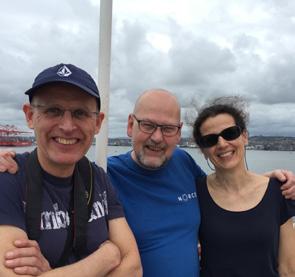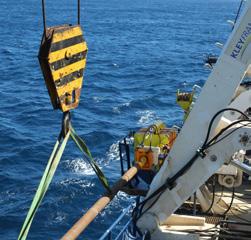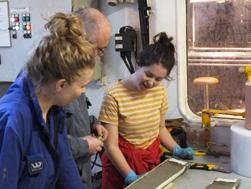
3 minute read
Marine cores
MD225 ACCLIMATE-2 crew and scientific team
SAMPLING MARINE SEDIMENT CORES
In February 2020, Margit Simon, Dag-Inge Blindheim, and Trond Dokken from SapienCE, in collaboration with colleagues from Cardiff University, UK and Vrije Universiteit Amsterdam, Netherland, joined a research expedition on board the French research vessel R/V Marion Dufresne.
SAMPLING MARINE SEDIMENTS
The main objective for the team was to core marine sediments that will be analysed to establish the sensitivity of the southern Agulhas Current to climatic changes during the Late Pleistocene. These cores will also be used to determine the influence of the Agulhas Current on African terrestrial climate, as part of SapienCE’s ongoing research into understanding the factors influencing human behavioural evolution. Two coring sites specifically targeted locations close to the archaeological sites at Blombos Cave (100-72 ka) and Klipdrift Shelter (66-59 ka) in the west, and Klasies River main site to the east. Before the 2020 research expedition, no marine sediment cores in close proximity to these key sites and covering the time period of interest existed.
The Agulhas Current is the strongest western boundary current in the Southern Hemisphere, transporting some 70 Sv (Sverdrup, 1 million cubic metres of water per second) of warm, saline surface water from the tropical Indian Ocean along the East African margin to the tip of Africa. The Agulhas Current is a key component of South African coastal ecosystem, supporting intertidal shellfish and fish communities and hence influencing the marine food sources that Middle Stone Age H. sapiens foraged. Moreover today, the warm Agulhas current drives the convection of moist coastal air cells that are important for coastal precipitation, delivering a source of freshwater to the region. This suggests that in the past the ocean temperature was important for controlling how much rainfall/freshwater was delivered to the coastal areas where the SapienCE sites are located.
The cruise retrieved two cores of excellent quality sediment, which will provide unique medium-to-high temporal resolution records, spanning the timeframe covered by SapienCE. The cores consists of terrestrial sediment transported out from land by rivers mixed with material from the ocean. Consequently, systematic analysis of material along the length of the core will allow us to reconstruct simultaneous variations in past ocean and land climate conditions during the Middle Stone Age.
STUDYING PAST CLIMATE
To study the coastal climate of South Africa, we use geochemical analysis to trace plant remains in the sediment, and elements such as iron or titanium that we know were transported from land to the ocean. These analyses allow us to reconstruct vegetation changes and variations in the amount of material transported from land to the


Ian Hall (Cardiff University) Trond Dokken (NORCE), and chief scientist Clair Waelbroeck (LOCEAN)
ocean over time. Using different geological dating methods, we can determine the age of each layer in the sediment core. With this information we can link our records of changing climate and vegetation with the archaeological information acquired from excavations along the South African coastline.
Moreover, we will analyse the ocean component of the core via planktonic foraminifera that we find in the sediment. Foraminifera are tiny unicellular animals with a calcite shell. Planktic foraminifera live in the ocean water column and form their shell from the seawater in which they live, meaning they preserve the fingerprint of that water mass in their shell. After they die, they sink and are buried and preserved in the sediments at the seafloor. By extracting ancient foraminifera from the core, and analysing their shell chemistry, we obtain a record of water mass properties (e.g., temperature and salinity) through time. With this data, we will, for example, be able to find out when ocean conditions were colder or warmer, hence more or less favourable for rainfall on land.
Overall, the data from our sediment cores will enable us to reconstruct environmental change through time, allowing us to interpret archaeological data in an accurate climatic context.
SapienCE researcher Margit Simon (NORCE) joined the cruise and authored this report

The Calypso coring system onboard R/V Marion Dufresne









